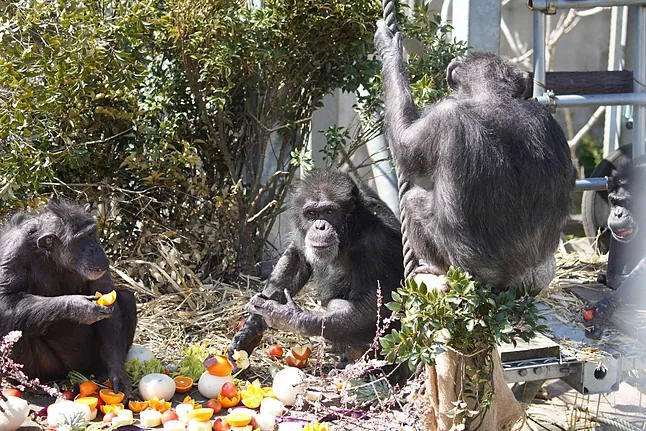"He who does not urinate in company, is either a thief or a spy." This Italian saying humorously summarizes an ancient social custom widespread in different cultures that, to the surprise of a team of Japanese researchers, is also practiced by our closest non-human relatives: chimpanzees.
Caretakers at the Kumamoto Sanctuary in Japan, home to 20 captive chimpanzees, noticed that these animals tended to urinate at the same time, reminiscent of human behavior. They wondered if it could be a contagious act, like when we yawn upon seeing someone else yawn, or rather a social behavior, as they point out, "the decision to urinate involves a complex combination of physiological and social considerations."
To find out, they began systematically recording how many times and under what circumstances these large primates urinated: they observed them for over 600 hours, during which they documented 1,328 occasions when the chimpanzees urinated. As detailed to this newspaper by Ena Onishi, co-author of the research and a doctoral student at the Wildlife Research Center of Kyoto University, they observed a total of 16 males and four females divided into five groups, each with five animals. They then analyzed the data to see if they synchronized when urinating, and if this behavior seemed to be influenced by social factors. Their results are published this Monday in the journal Current Biology.
"Our research suggests that this phenomenon may have deep evolutionary roots. We discovered that chimpanzees, our closest relatives, tend to urinate in response to when other nearby individuals do so," explains Ena Onishi via email, admitting, however, that they could not draw conclusions about whether female chimpanzees were more likely to urinate together, as is often the case with women. "The 20 chimpanzees were divided into four groups; in three of them there were five males, and in the other group, four females and one male. This limitation makes it difficult to investigate how much the sex of the animal influences, as it is not just about whether they are males or females, but also about the differences in the structure of each group and the dynamics between individuals of the same sex or mixed groups, which are not directly comparable in our study," she explains.
According to their colleague Shinya Yamamoto, co-author of the study, this is the "first study investigating contagious urination in animals, including humans." "In humans, we know that our decision to urinate is influenced by social contexts that lead us to do it simultaneously with others, and that this joint activity could promote greater social bonding. Our study with chimpanzees clearly shows that these large primates share some similarities on this topic, suggesting the deep evolutionary origin of contagious urination," he argues.
Thus, their analysis showed that urination events were significantly more synchronized than would be expected if chimpanzees simply urinated at random times. A striking conclusion is that individuals with less dominance in the group were more likely to urinate when others did. A finding that suggests that urination patterns are influenced by social hierarchy, with a tendency for the behavior to "flow down the dominance structure," according to this Japanese team.
As detailed by Yamamoto, the study also revealed some possible differences between chimpanzees and humans: "Chimpanzee urination was influenced by dominance relationships but not by affiliative relationships among them," the scientist points out.
"We were surprised to discover that the contagion pattern was influenced by social hierarchy," admits Onishi. "Since there were no previous studies on contagious urination in any species, we initially drew parallels with contagious yawning, another semi-voluntary physiological behavior. Based on this, we expected that any social influence might resemble what is observed in yawning, such as stronger contagion among close individuals. However, our results did not show a relationship with social proximity but rather a clear influence of social rank, with individuals of lower rank in the group being more likely to follow those of higher rank when urinating."
As Shinya Yamamoto anticipates, they now want to further investigate the differences they have seen between humans and chimpanzees.
So far, chimpanzees are the only great apes in which they have studied this behavior, although bonobos also live in the sanctuary. "Researching with them in our facilities is a challenge due to the group size issue. However, investigating this behavior in bonobos (our closest relatives along with chimpanzees, but with very different social structures) could provide particularly intriguing information compared to our findings in chimpanzees," says the researcher.
As Shinya Yamamoto reviews, "apes have a wide variety of social structures and dynamics. For example, both chimpanzees and bonobos form multi-male, multi-female fission-fusion societies. Chimpanzee society is more competitive by nature but may excel in group cooperation, such as cooperative hunting and border patrolling, while bonobos have a more peaceful society characterized by high tolerance among individuals." Gorillas, on the other hand, "form a family-like society, typically with a single adult male and several females and offspring, while orangutans are basically solitary. These differences can also influence their decision to urinate," the scientist points out.
Asked whether this observed tendency in chimpanzees to urinate at the same time in the sanctuary may have been favored by living in captivity, Ena Onishi states that while their results "may be influenced by captivity," she believes that this behavior could also be observed in wild chimpanzees. "This is because we consider contagious urination as something natural, similar to behaviors like yawning or scratching when other group members do it, rather than something strategic, cultural, or learned," she reflects.
These findings, argue the team, "may have important implications for understanding and exploring the role of this seemingly mundane behavior in maintaining group cohesion and coordination or reinforcing social bonds among its members."
